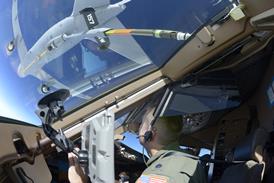Aerospatiale and the French research agency Onera have developed an active-control technique to overcome problems of structural flexing in airframes.
With the adoption of fly-by-wire technology, there are opportunities to optimise the control laws which translate pilot inputs into aircraft dynamics, which in turn determine aircraft performance, passenger comfort and, ultimately, the fatigue life of the airframe .
Although not a threat to safety, structural flexing of the airframe can introduce effects which can negate these benefits.
In the past, electronic filters have been used, but in certain phases of flight of large or "stretched" aircraft (such as the proposed Airbus A340-600), the flexing frequencies can coincide with those input by the pilot.
This has led Aerospatiale, with Onera, to develop an active control technique relying on motion transducers in the aircraft's extremities to feed back signals to the aircraft's flight-control computers, allowing the machines to compensate in real time for flexing.
After four years of research, the technique was recently validated using an A340-300 testbed.
Future large airliners such as the A3XX are likely to incorporate the concept as standard.
Source: Flight International























